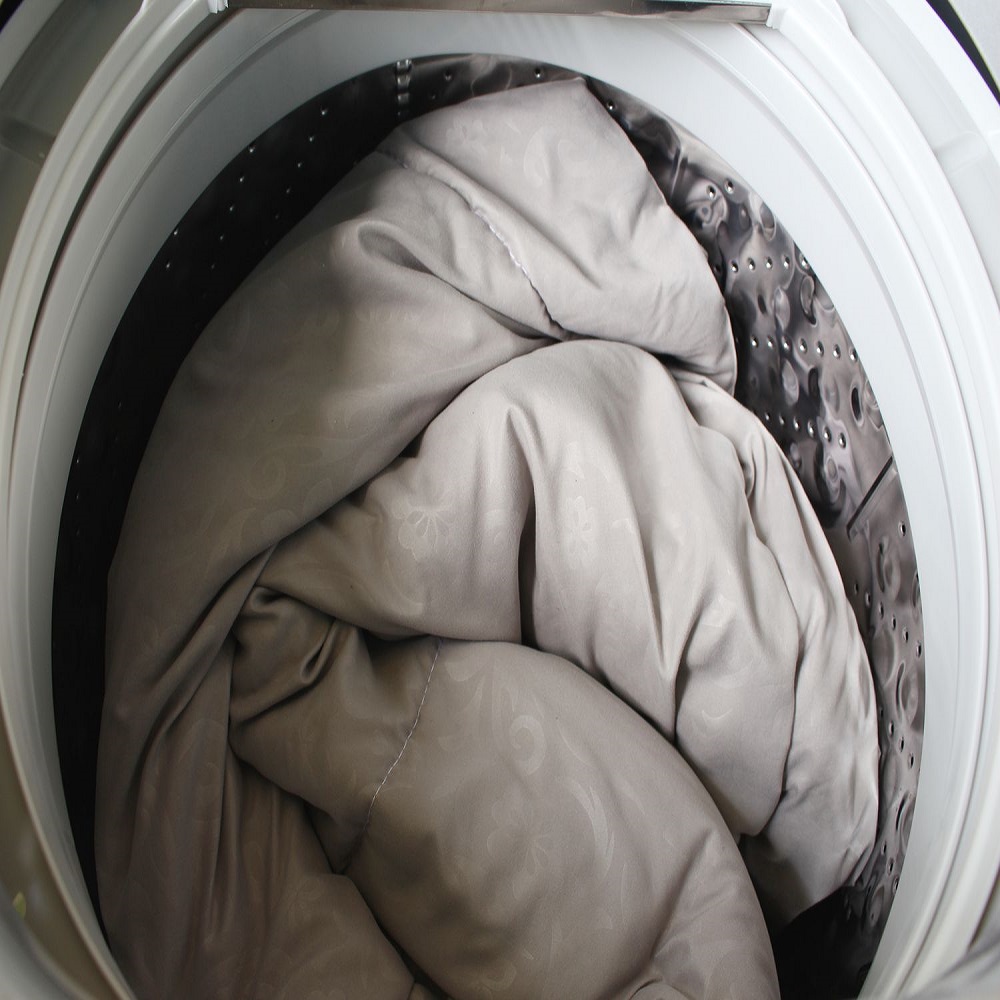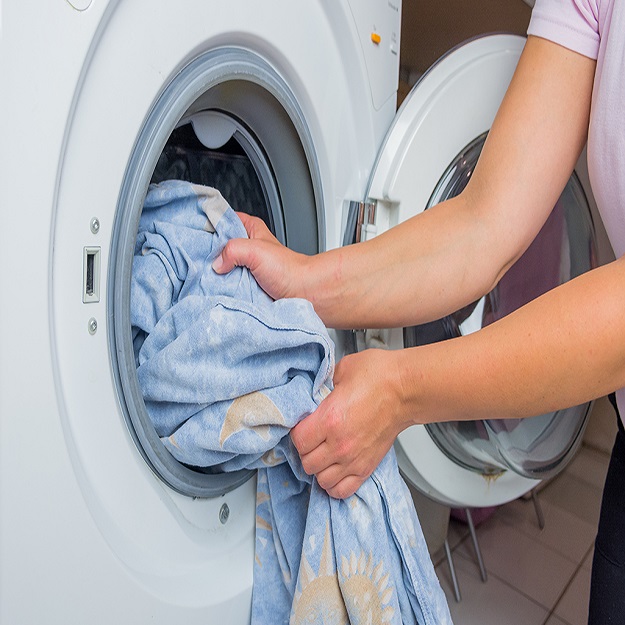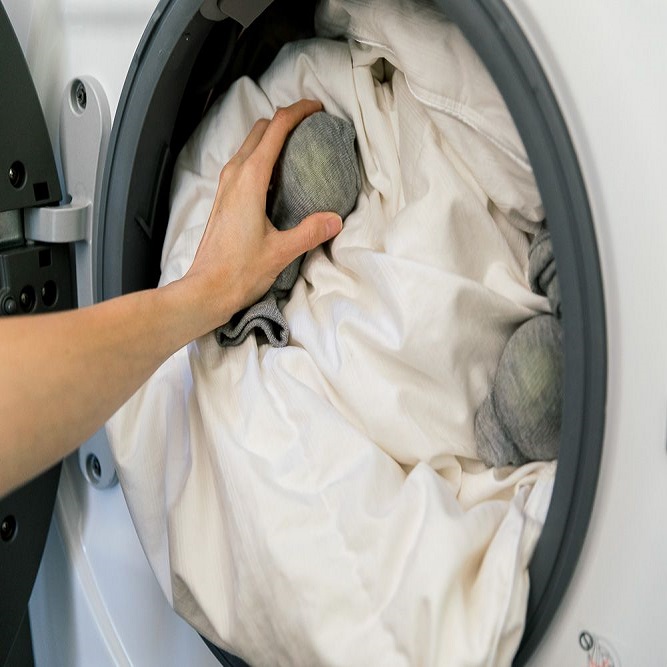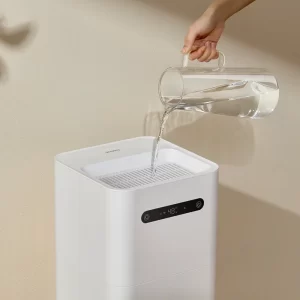How to Wash a Comforter in a Washing Machine?
Introduction:
In 2024 keeping your comforter clean is essential for maintaining its freshness and extending its lifespan. Washing a comforter in a washing machine, though daunting due to its size, can be done effectively with the right steps and care. This detailed guide explores the various aspects of washing a comforter in a machine, ensuring a thorough clean without causing damage. From preparation to drying, each step is crucial in achieving the best results.

How to wash a comforter in a small washer?
Preparing the Comforter and Machine
Proper preparation of both the comforter and the washing machine sets the stage for a successful wash.
Check Care Labels: Examine the care label on your comforter. This label provides specific washing instructions such as water temperature, cycle type, and drying recommendations. Follow these guidelines closely to avoid damaging the comforter.
Inspect for Damage: Before washing, inspect the comforter for any minor tears, loose threads, or weak spots. Repair any minor damage to prevent it from worsening during the wash cycle.
Remove Covers: If your comforter has a removable cover, such as a duvet cover, remove it and wash the cover separately. This allows the comforter to be cleaned more thoroughly.
Select Appropriate Detergent: Use a mild liquid detergent that is suitable for delicate fabrics. Avoid using harsh detergents or bleach, as these can damage the comforter’s material and filling.
Load Capacity: Ensure your washing machine is large enough to accommodate the comforter. Front-loading machines are generally better for washing bulky items as they often have larger capacities and provide a gentler wash compared to top-loading machines.

Choosing the Right Wash Cycle
Selecting the correct wash cycle is crucial for cleaning the comforter effectively without causing harm.
Gentle Cycle: Use the gentle or delicate cycle setting on your washing machine. This cycle uses slower agitation and a slower spin speed, reducing the risk of damaging the comforter.
Cold Water: Opt for cold water during the wash cycle. Cold water helps to preserve the fabric and colors of the comforter while minimizing shrinkage and preventing any filling from clumping.
Extra Rinse: Select an extra rinse cycle to ensure all detergent residues are thoroughly removed. Residual detergent can cause the comforter to feel stiff or cause skin irritation.
Balance the Load: To ensure a balanced load and effective cleaning, consider adding a few towels or other small items to the machine. This helps to distribute the weight evenly and prevents the comforter from bunching up.
Using Proper Washing Techniques
Employing the right washing techniques ensures that your comforter remains in good condition throughout the process.
Even Distribution: Place the comforter loosely in the washing machine, ensuring it is distributed evenly. Avoid cramming or folding it tightly, as this can prevent thorough cleaning.
Washing Balls or Tennis Balls: Add a few washing balls or clean tennis balls to the machine. These help keep the filling evenly distributed and prevent clumping during the wash cycle.
Monitor the Machine: Keep an eye on the washing machine during the cycle. If the machine becomes unbalanced or the comforter starts to bunch up, pause the cycle and redistribute the comforter to maintain balance.
Avoid Overloading: Do not overload the washing machine. If the comforter feels too tight or the machine struggles to rotate, consider using a larger machine or taking the comforter to a laundromat with commercial-sized washers.

Special Considerations for Different Types of Comforters
Different materials and fillings require specific care. Understanding these differences ensures you wash each type of comforter correctly.
Down Comforters: Down comforters are filled with down feathers and require extra care. Use a down-specific detergent or a mild, gentle detergent. Make sure to thoroughly rinse to remove all detergent residues. Avoid excessive heat during drying to prevent damaging the down filling.
Synthetic Comforters: Synthetic comforters are more durable and can typically withstand a regular wash cycle. However, it is still best to use a gentle cycle and cold water to prevent any damage to the synthetic fibers.
Wool Comforters: Wool comforters are naturally resistant to dust mites and mold but require careful handling to avoid shrinkage. Use cold water and a gentle cycle. Wool-specific detergents are recommended, and avoid high heat during drying.
Cotton Comforters: Cotton comforters are relatively easy to care for. Use a mild detergent, wash in cold water, and opt for a gentle cycle. Ensure the comforter is thoroughly dry to prevent mold and mildew.
Drying the Comforter Properly
Drying the comforter correctly is as important as washing it, ensuring it retains its shape, fluffiness, and cleanliness.
Tumble Dry on Low: Place the comforter in the dryer and tumble dry on a low heat setting. High heat can damage the fabric and filling, leading to clumping or shrinkage. Check the comforter periodically to ensure it’s drying evenly.
Drying Balls or Tennis Balls: Add a few clean tennis balls or dryer balls to the dryer. These help to fluff the filling and prevent it from clumping.
Frequent Fluffing: Every 30 minutes or so, pause the dryer and fluff the comforter by hand. Redistribute the filling to ensure even drying and prevent any areas from staying damp.
Air Drying: If the weather permits, consider air-drying the comforter outdoors. Lay it flat on a clean surface or hang it across a clothesline. Ensure it is spread evenly to prevent lumps and turn it regularly for uniform drying.
Avoid Sun Exposure: While air-drying, limit direct sun exposure to prevent fabric damage and color fading. Use an area with plenty of indirect sunlight and air circulation.
Full Drying: Ensure the comforter is completely dry before using or storing it. Any moisture left can lead to mildew and musty odors.

Dealing with Tough Stains
Tough stains require special attention to ensure they are fully removed without damaging the comforter.
Pre-Treating Stains: Identify any stains before washing and pre-treat them with a stain remover or a mixture of mild detergent and water. Gently dab the stain with the solution and let it sit for a few minutes before washing.
Avoid Rubbing: Do not rub the stains vigorously, as this can spread the stain and weaken the fabric fibers. Use a soft brush or cloth to gently treat the affected area.
Spot Cleaning: For localized stains, consider spot cleaning instead of washing the entire comforter. Use a small amount of detergent mixed with water and a clean cloth to treat the stain directly.
Repeat if Necessary: Some tough stains might require multiple treatments. Be patient and repeat the pre-treatment process if the stain doesn’t come out entirely in the first wash.
Maintaining Freshness Between Washes
To keep your comforter fresh and clean in between washes, follow some essential maintenance tips.
Regular Fluffing: Fluff your comforter regularly to maintain its loft and prevent the filling from settling. This keeps the comforter airy and comfortable.
Use a Duvet Cover: Using a duvet cover can significantly reduce the need to wash the comforter frequently. Duvet covers protect the comforter from dirt, stains, and wear, and are easier to wash and replace.
Air Out Periodically: Periodically air out your comforter by hanging it outside on a dry, breezy day. This helps to refresh the fabric and fillings and eliminate any built-up odors.
Spot Clean When Necessary: Promptly address any spills or stains by spot cleaning the comforter. This prevents small stains from becoming bigger issues and reduces the need for frequent full washes.
Store Properly: When not in use, store your comforter in a breathable cotton bag or cover to protect it from dust and moisture. Avoid using plastic bags, as they can trap moisture and lead to mildew.
Professional Cleaning Considerations
Sometimes, professional cleaning might be the best option for your comforter, particularly for delicate or heavily soiled items.
Dry Cleaning: For comforters labeled as “dry clean only,” it is essential to follow these guidelines. Take the comforter to a reputable dry cleaner that has experience handling such items.
Commercial Laundromats: If your home washing machine is not large enough, consider using a commercial laundromat with larger machines. These facilities often have oversized washers and dryers suitable for comforters.
High-End Comforters: High-end or specialty comforters, especially those made from delicate materials or with intricate detailing, may benefit from professional cleaning to ensure they receive the best care.
Energy Efficiency and Eco-Friendly Practices
Washing and drying a comforter can be energy-intensive. Adopt eco-friendly practices to minimize your environmental footprint.
Energy-Efficient Appliances: Use energy-efficient washing machines and dryers if available. These appliances consume less water and energy, reducing utility bills and environmental impact.
Cold Water Wash: Cold water washing is not only better for your comforter but also saves energy used to heat the water. Modern detergents are effective even at low temperatures, ensuring cleanliness without excess energy use.
Air Drying: Whenever possible, opt for air drying. This practice saves energy and can be gentler on the comforter, prolonging its lifespan.
Eco-Friendly Detergents: Choose eco-friendly, biodegradable detergents that are gentle on the environment and safe for your comforter’s materials.
Common Mistakes to Avoid
Avoiding common mistakes ensures that your comforter remains in good condition during and after washing.
Overloading the Machine: Do not overload the washing machine, as it can lead to incomplete cleaning and damaged fabrics. Ensure there is enough space for the comforter to move and get thoroughly washed.
Using Harsh Chemicals: Avoid using bleach or harsh detergents, as these can degrade the fabric and filling, reducing the comforter’s lifespan and comfort.
Excessive Heat: Do not use high heat settings in the dryer, as this can shrink and damage the comforter. Always opt for a low or no-heat setting.
Ignoring Care Labels: Always follow the care instructions on your comforter’s label. Ignoring these guidelines can lead to damage and void any warranties.
Incomplete Drying: Ensure the comforter is completely dry before storing or using it to prevent mildew and odors. Dampness can lead to unpleasant smells and health issues.
 Conclusion
Conclusion
Washing a comforter in a washing machine involves careful preparation, the right techniques, proper cycle selection, and appropriate drying methods. Understanding the specific needs of different types of comforters and avoiding common mistakes ensures that your comforter remains clean, fresh, and damage-free. By following this comprehensive guide, you can keep your comforter in excellent condition, maintain its durability, and enjoy its comfort for years to come.

